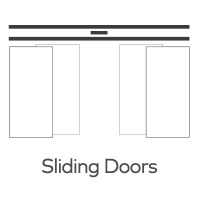Quelles mesures sont prises pour minimiser la consommation d'énergie des capteurs laser dans les portes automatiques?
Les capteurs laser sont un élément essentiel des portes automatiques, fournissant la précision et la fiabilité nécessaires pour un fonctionnement efficace. Alors que l'efficacité énergétique devient de plus en plus importante dans les espaces résidentiels et commerciaux, les fabricants mettent en œuvre diverses mesures pour minimiser la consommation d'énergie des capteurs laser. Ces innovations garantissent que les portes automatiques sont non seulement fonctionnelles et pratiques, mais aussi respectueuses de l'environnement et économiques. Voici un aperçu plus approfondi des stratégies et technologies utilisées pour réduire la demande énergétique des capteurs laser dans les portes automatiques.
1. Développement de composants à faible puissance
L'une des façons les plus directes de réduire la consommation d'énergie est de concevoir des capteurs laser avec des composants matériels à faible puissance. Les progrès de la technologie des semi-conducteurs ont permis aux fabricants de créer des circuits et des lasers hautement efficaces qui nécessitent une énergie minimale pour fonctionner.
Exemples d'innovations à faible puissance:
- Diodes laser économes en énergie: Les capteurs modernes utilisent des diodes qui émettent des faisceaux laser précis tout en consommant moins d'énergie.
- Microcontrôleurs optimisés: Ces unités de commande gèrent efficacement les opérations du capteur, réduisant le gaspillage d'énergie.
Cet accent mis sur la conception économe en énergie garantit que les capteurs ne consomment que la quantité d'énergie nécessaire pour exécuter leurs tâches.
2. Utilisation des modes de veille et de sommeil
Pour économiser de l'énergie pendant les périodes d'inactivité, de nombreux capteurs laser sont équipés de modes de veille ou de sommeil. Ces modes permettent au capteur de réduire considérablement sa consommation d'énergie lorsque aucun mouvement ou activité n'est détecté près de la porte.
Comment fonctionne-t-il:
- Le capteur entre dans un état de faible puissance lorsque la zone est non occupée. Il réactive instantanément lorsque le mouvement est détecté, assurant une fonctionnalité sans faille. Dans les zones à faible circulation, les modes de sommeil peuvent économiser des quantités substantielles d'énergie au fil du temps.
3. La technologie de détection adaptative est conçue pour optimiser l'utilisation d'énergie des capteurs laser en fonction des conditions environnementales et des schémas d'utilisation en temps réel. Cette approche assure que les capteurs ajustent leurs performances dynamiquement pour économiser de l'énergie.Caractéristiques de la détection adaptative:
- Modulation d'intensité: Les capteurs réduisent l'intensité du faisceau laser pendant les périodes de faible activité.
- Taux de balayage dynamiques: La fréquence des balayages est réduite dans des environnements moins occupés, ce qui permet d'économiser de l'énergie tout en maintenant la fonctionnalité. Cette technologie permet aux capteurs de fonctionner efficacement sans compromettre la précision ou la réactivité.
4. Intégration avec les systèmes de gestion de l'énergie
Les bâtiments modernes comptent de plus en plus sur les systèmes de gestion de l'énergie (SGE) pour surveiller et contrôler la consommation d'énergie sur tous les appareils. Les capteurs laser dans les portes automatiques peuvent désormais s’intégrer à ces systèmes, permettant une optimisation centralisée de l’énergie.
Avantages de l'intégration:
- Équilibrage de charge: Les systèmes EMS ne peuvent allouer de l'énergie aux capteurs laser que lorsque cela est nécessaire.
- Programmation énergétique: Les capteurs peuvent suivre des horaires programmés, restant actifs uniquement pendant les heures de trafic élevé.
- Analyse des données: Les systèmes EMS collectent des données sur l'utilisation des capteurs, permettant aux gestionnaires de bâtiments d'identifier et d'éliminer les inefficacités.
5. Les progrès de la miniaturisation ont permis aux fabricants de créer des capteurs laser compacts qui nécessitent moins d'énergie pour fonctionner. Les capteurs plus petits consomment par nature moins d'énergie tout en maintenant le même niveau de fonctionnalité et de précision que les modèles plus grands. Avantages des capteurs miniaturisés:
- Consommation d'énergie réduite en raison des composants matériels plus petits.
- Coûts de fabrication et d'entretien plus bas.
- Intégration plus facile dans les portes automatiques avec un impact minimal sur l'esthétique du design.
6. Mise en œuvre de zones de détection intelligentes Les capteurs laser dotés de capacités de détection intelligentes sont conçus pour concentrer leur énergie uniquement là où elle est nécessaire. En créant des zones de détection précises, ces capteurs évitent de gaspiller de l'énergie sur des zones inutiles. Caractéristiques clés des zones intelligentes:
- Activation sélective: Les capteurs activent des zones de détection spécifiques en fonction des schémas de trafic attendus.
- Focus de faisceau étroit: Le faisceau laser cible une zone plus petite, réduisant la consommation d'énergie globale.
- Paramètres personnalisables: Les gestionnaires de bâtiment peuvent configurer des zones de détection pour minimiser les activations inutiles.
7. Utilisation des sources d'énergie renouvelables
Dans certains cas, les portes automatiques et leurs capteurs sont alimentés par des systèmes d'énergie renouvelable, tels que des panneaux solaires. Cela réduit l'impact environnemental global des capteurs et rend leur consommation d'énergie plus durable.
Applications des énergies renouvelables:
- Dans des endroits éloignés ou des installations extérieures, les capteurs à énergie solaire offrent une solution autosuffisante. Combinée à une conception économe en énergie, les énergies renouvelables peuvent rendre les systèmes de portes automatiques entièrement écologiques.
8. Amélioration de la gestion thermique
La génération de chaleur est un sous-produit commun des composants électroniques et une chaleur excessive peut entraîner des inefficacités. Les capteurs laser modernes sont conçus avec des systèmes de gestion thermique améliorés pour réduire les pertes d'énergie associées à la dissipation de chaleur.
Techniques de gestion thermique:
- Dispenseurs de chaleur efficaces: Aider à maintenir des températures de fonctionnement optimales pour les capteurs.
- Caractéristiques d'arrêt thermique: Évitez la surchauffage des capteurs, réduisez le gaspillage d'énergie et prolongez la durée de vie de l'appareil.
9. Optimisation avancée du logiciel
Le logiciel joue un rôle essentiel dans le contrôle de la façon dont les capteurs laser utilisent l'énergie. Des algorithmes avancés sont utilisés pour optimiser les performances des capteurs, en veillant à ce qu'ils ne fonctionnent que lorsque cela est nécessaire.
Mesures basées sur des logiciels:
- Algorithmes prédictifs: Anticiper le comportement de l'utilisateur pour activer les capteurs uniquement lorsque cela est nécessaire.
- Réduction des erreurs: Réduire au minimum les fausses activations qui entraînent une utilisation inutile d'énergie. Les mises à jour régulières améliorent l'efficacité des capteurs et mettent en œuvre les dernières fonctionnalités d'économie d'énergie.
10. Conformité réglementaire et normes
Les fabricants de capteurs laser pour portes automatiques doivent respecter les règlements et normes d'efficacité énergétique, tels que ceux établis par la Commission électrotechnique internationale (CEI) ou le Département américain de l'énergie (DOE). Ces normes encouragent le développement de dispositifs à faible puissance et veillent à ce que les capteurs répondent à des critères stricts de consommation d'énergie.
Impact de la conformité:
- Encourage l'innovation dans les technologies économes en énergie. Assure aux clients de recevoir des produits avec des caractéristiques d'économie d'énergie garanties.
Conclusion
La réduction de la consommation d'énergie des capteurs laser dans les portes automatiques est une étape cruciale vers la création de bâtiments plus économes en énergie et durables. Grâce aux progrès réalisés dans les composants à faible consommation, la détection adaptative, les zones de détection intelligentes et l'intégration avec les systèmes de gestion de l'énergie, les fabricants réduisent considérablement la demande énergétique de ces appareils. À mesure que la technologie continue d'évoluer, l'accent mis sur l'efficacité énergétique stimulera d'autres innovations dans la conception de capteurs laser, au bénéfice des opérateurs de bâtiments, des occupants et de l'environnement. En adoptant ces mesures d’économie d’énergie, les systèmes de portes automatiques contribuent à un avenir plus écologique et plus durable.
4. Intégration avec les systèmes de gestion de l'énergie
Les bâtiments modernes comptent de plus en plus sur les systèmes de gestion de l'énergie (SGE) pour surveiller et contrôler la consommation d'énergie sur tous les appareils. Les capteurs laser dans les portes automatiques peuvent désormais s’intégrer à ces systèmes, permettant une optimisation centralisée de l’énergie.
Avantages de l'intégration:
- Équilibrage de charge: Les systèmes EMS ne peuvent allouer de l'énergie aux capteurs laser que lorsque cela est nécessaire.
- Programmation énergétique: Les capteurs peuvent suivre des horaires programmés, restant actifs uniquement pendant les heures de trafic élevé.
- Analyse des données: Les systèmes EMS collectent des données sur l'utilisation des capteurs, permettant aux gestionnaires de bâtiments d'identifier et d'éliminer les inefficacités.
5. Les progrès de la miniaturisation ont permis aux fabricants de créer des capteurs laser compacts qui nécessitent moins d'énergie pour fonctionner. Les capteurs plus petits consomment par nature moins d'énergie tout en maintenant le même niveau de fonctionnalité et de précision que les modèles plus grands. Avantages des capteurs miniaturisés:
- Consommation d'énergie réduite en raison des composants matériels plus petits.
- Coûts de fabrication et d'entretien plus bas.
- Intégration plus facile dans les portes automatiques avec un impact minimal sur l'esthétique du design.
6. Mise en œuvre de zones de détection intelligentes Les capteurs laser dotés de capacités de détection intelligentes sont conçus pour concentrer leur énergie uniquement là où elle est nécessaire. En créant des zones de détection précises, ces capteurs évitent de gaspiller de l'énergie sur des zones inutiles. Caractéristiques clés des zones intelligentes:
- Activation sélective: Les capteurs activent des zones de détection spécifiques en fonction des schémas de trafic attendus.
- Focus de faisceau étroit: Le faisceau laser cible une zone plus petite, réduisant la consommation d'énergie globale.
- Paramètres personnalisables: Les gestionnaires de bâtiment peuvent configurer des zones de détection pour minimiser les activations inutiles.
7. Utilisation des sources d'énergie renouvelables
Dans certains cas, les portes automatiques et leurs capteurs sont alimentés par des systèmes d'énergie renouvelable, tels que des panneaux solaires. Cela réduit l'impact environnemental global des capteurs et rend leur consommation d'énergie plus durable.
Applications des énergies renouvelables:
- Dans des endroits éloignés ou des installations extérieures, les capteurs à énergie solaire offrent une solution autosuffisante. Combinée à une conception économe en énergie, les énergies renouvelables peuvent rendre les systèmes de portes automatiques entièrement écologiques.
8. Amélioration de la gestion thermique
La génération de chaleur est un sous-produit commun des composants électroniques et une chaleur excessive peut entraîner des inefficacités. Les capteurs laser modernes sont conçus avec des systèmes de gestion thermique améliorés pour réduire les pertes d'énergie associées à la dissipation de chaleur.
Techniques de gestion thermique:
- Dispenseurs de chaleur efficaces: Aider à maintenir des températures de fonctionnement optimales pour les capteurs.
- Caractéristiques d'arrêt thermique: Évitez la surchauffage des capteurs, réduisez le gaspillage d'énergie et prolongez la durée de vie de l'appareil.
9. Optimisation avancée du logiciel
Le logiciel joue un rôle essentiel dans le contrôle de la façon dont les capteurs laser utilisent l'énergie. Des algorithmes avancés sont utilisés pour optimiser les performances des capteurs, en veillant à ce qu'ils ne fonctionnent que lorsque cela est nécessaire.
Mesures basées sur des logiciels:
- Algorithmes prédictifs: Anticiper le comportement de l'utilisateur pour activer les capteurs uniquement lorsque cela est nécessaire.
- Réduction des erreurs: Réduire au minimum les fausses activations qui entraînent une utilisation inutile d'énergie. Les mises à jour régulières améliorent l'efficacité des capteurs et mettent en œuvre les dernières fonctionnalités d'économie d'énergie.
10. Conformité réglementaire et normes
Les fabricants de capteurs laser pour portes automatiques doivent respecter les règlements et normes d'efficacité énergétique, tels que ceux établis par la Commission électrotechnique internationale (CEI) ou le Département américain de l'énergie (DOE). Ces normes encouragent le développement de dispositifs à faible puissance et veillent à ce que les capteurs répondent à des critères stricts de consommation d'énergie.
Impact de la conformité:
- Encourage l'innovation dans les technologies économes en énergie. Assure aux clients de recevoir des produits avec des caractéristiques d'économie d'énergie garanties.
Conclusion
La réduction de la consommation d'énergie des capteurs laser dans les portes automatiques est une étape cruciale vers la création de bâtiments plus économes en énergie et durables. Grâce aux progrès réalisés dans les composants à faible consommation, la détection adaptative, les zones de détection intelligentes et l'intégration avec les systèmes de gestion de l'énergie, les fabricants réduisent considérablement la demande énergétique de ces appareils. À mesure que la technologie continue d'évoluer, l'accent mis sur l'efficacité énergétique stimulera d'autres innovations dans la conception de capteurs laser, au bénéfice des opérateurs de bâtiments, des occupants et de l'environnement. En adoptant ces mesures d’économie d’énergie, les systèmes de portes automatiques contribuent à un avenir plus écologique et plus durable.
Caractéristiques clés des zones intelligentes:
- Activation sélective: Les capteurs activent des zones de détection spécifiques en fonction des schémas de trafic attendus.
- Focus de faisceau étroit: Le faisceau laser cible une zone plus petite, réduisant la consommation d'énergie globale.
- Paramètres personnalisables: Les gestionnaires de bâtiment peuvent configurer des zones de détection pour minimiser les activations inutiles.
7. Utilisation des sources d'énergie renouvelables
Dans certains cas, les portes automatiques et leurs capteurs sont alimentés par des systèmes d'énergie renouvelable, tels que des panneaux solaires. Cela réduit l'impact environnemental global des capteurs et rend leur consommation d'énergie plus durable.
Applications des énergies renouvelables:
- Dans des endroits éloignés ou des installations extérieures, les capteurs à énergie solaire offrent une solution autosuffisante. Combinée à une conception économe en énergie, les énergies renouvelables peuvent rendre les systèmes de portes automatiques entièrement écologiques.
8. Amélioration de la gestion thermique
La génération de chaleur est un sous-produit commun des composants électroniques et une chaleur excessive peut entraîner des inefficacités. Les capteurs laser modernes sont conçus avec des systèmes de gestion thermique améliorés pour réduire les pertes d'énergie associées à la dissipation de chaleur.
Techniques de gestion thermique:
- Dispenseurs de chaleur efficaces: Aider à maintenir des températures de fonctionnement optimales pour les capteurs.
- Caractéristiques d'arrêt thermique: Évitez la surchauffage des capteurs, réduisez le gaspillage d'énergie et prolongez la durée de vie de l'appareil.
9. Optimisation avancée du logiciel
Le logiciel joue un rôle essentiel dans le contrôle de la façon dont les capteurs laser utilisent l'énergie. Des algorithmes avancés sont utilisés pour optimiser les performances des capteurs, en veillant à ce qu'ils ne fonctionnent que lorsque cela est nécessaire.
Mesures basées sur des logiciels:
- Algorithmes prédictifs: Anticiper le comportement de l'utilisateur pour activer les capteurs uniquement lorsque cela est nécessaire.
- Réduction des erreurs: Réduire au minimum les fausses activations qui entraînent une utilisation inutile d'énergie. Les mises à jour régulières améliorent l'efficacité des capteurs et mettent en œuvre les dernières fonctionnalités d'économie d'énergie.
10. Conformité réglementaire et normes
Les fabricants de capteurs laser pour portes automatiques doivent respecter les règlements et normes d'efficacité énergétique, tels que ceux établis par la Commission électrotechnique internationale (CEI) ou le Département américain de l'énergie (DOE). Ces normes encouragent le développement de dispositifs à faible puissance et veillent à ce que les capteurs répondent à des critères stricts de consommation d'énergie.
Impact de la conformité:
- Encourage l'innovation dans les technologies économes en énergie. Assure aux clients de recevoir des produits avec des caractéristiques d'économie d'énergie garanties.
Conclusion
La réduction de la consommation d'énergie des capteurs laser dans les portes automatiques est une étape cruciale vers la création de bâtiments plus économes en énergie et durables. Grâce aux progrès réalisés dans les composants à faible consommation, la détection adaptative, les zones de détection intelligentes et l'intégration avec les systèmes de gestion de l'énergie, les fabricants réduisent considérablement la demande énergétique de ces appareils. À mesure que la technologie continue d'évoluer, l'accent mis sur l'efficacité énergétique stimulera d'autres innovations dans la conception de capteurs laser, au bénéfice des opérateurs de bâtiments, des occupants et de l'environnement. En adoptant ces mesures d’économie d’énergie, les systèmes de portes automatiques contribuent à un avenir plus écologique et plus durable.







